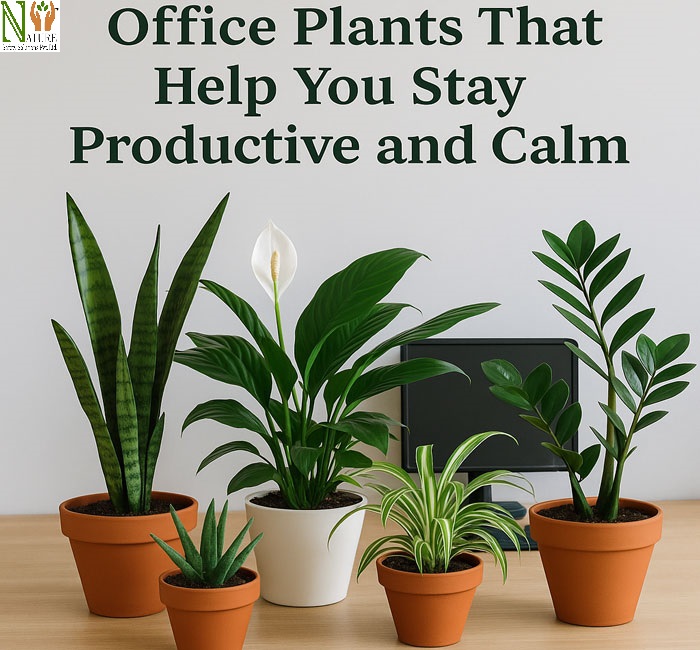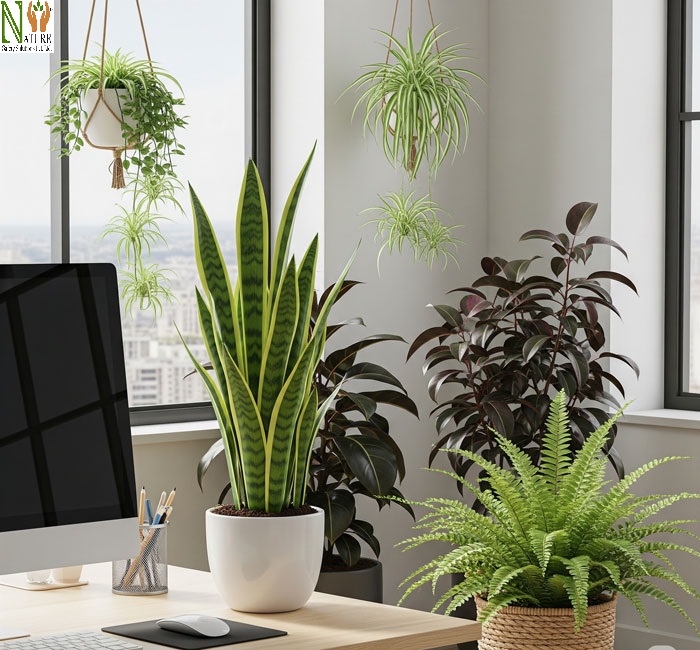In today’s fast-paced work environment, stress and distractions can easily derail our focus and productivity. One simple yet powerful solution? Indoor office plants.
Adding greenery to your workspace does more than just beautify the surroundings—it has real mental, emotional, and even physical health benefits.
Numerous studies have shown that plants can boost productivity, reduce stress, purify the air, and improve overall workplace satisfaction.
Let’s explore how office plants help you stay productive and calm, and which ones are best suited for different office environments.

Why Plants Belong in the Office
1. Improved Air Quality
Office spaces often have limited ventilation, leading to a buildup of carbon dioxide and indoor pollutants. Many indoor plants help filter toxins from the air and increase oxygen levels, creating a cleaner and healthier atmosphere. Better air means better focus and fewer sick days.
2. Reduced Stress and Anxiety
Plants have a calming psychological effect. Research shows that simply being around greenery can lower heart rate, reduce cortisol levels (the stress hormone), and promote a more relaxed state of mind.
3. Enhanced Concentration and Memory
Natural elements like plants can help improve cognitive function and memory retention. Studies suggest that people working in green office environments are more attentive and productive.
4. Boosted Mood and Job Satisfaction
Green spaces tend to increase feelings of happiness and satisfaction. Employees report higher morale and greater enjoyment of their work when their environment includes natural elements.
Top Office Plants That Promote Calm and Productivity
If you’re looking to bring some greenery into your workspace, these indoor plants are ideal choices. They’re easy to care for, help purify the air, and create a peaceful atmosphere that supports focus and calm.
1. Snake Plant
This upright, stylish plant is one of the easiest to maintain. It’s well-known for tolerating low light and neglect, making it perfect for busy office settings. It also works as a natural air filter, removing toxins like formaldehyde and benzene from the air.
Care: Let the soil dry completely between waterings. It prefers indirect light but can handle low-light corners.
2. Peace Lily
Elegant and graceful, the peace lily adds a touch of beauty with its white blooms. It’s also highly effective at improving indoor air quality.
Care: Keep the soil slightly moist and place the plant in indirect sunlight. It wilts when it needs water, which makes it easy to care for.
3. Spider Plant
Great for beginners, the spider plant grows quickly and is very forgiving. Its striped leaves and arching growth make it visually interesting, and it also helps clean the air.
Care: Place in bright, indirect light and water when the top inch of soil feels dry.
4. Pothos
One of the most popular houseplants, pothos is known for its trailing vines and ability to thrive in various conditions. It’s perfect for shelves, pots, or hanging baskets.
Care: Grows well in low to medium light. Water when the soil feels dry to the touch.
5. ZZ Plant (Zamioculcas zamiifolia)
If you often forget to water your plants, this one’s for you. The ZZ plant can survive in low light and with little water, all while adding a modern touch to your workspace.
Care: Water occasionally—every 2–3 weeks is often enough. It prefers low to moderate light.
6. Aloe Vera
Aloe brings more than just good looks—it contains a soothing gel used to treat minor skin irritations. It’s also great for purifying the air.
Care: Needs bright, indirect sunlight. Water deeply but only when the soil is completely dry.
7. Lavender
Lavender not only looks beautiful but also releases a calming scent that helps reduce anxiety and lift your mood.
Care: Requires plenty of sunlight. Let the soil dry out between waterings to prevent root rot.

Tips for Keeping Office Plants Healthy
To keep your office plants in good shape, start by picking the right ones for your space. Think about how much sunlight the area gets, how warm or cool it stays, and how often you can care for them. Choose plants that match those conditions.
Watering is important, but too much can do more harm than good. Most indoor plants prefer to dry out a bit before the next watering. Also, don’t forget to gently wipe the leaves—dust can build up and block the light they need to grow.
Make sure your pots have proper drainage to prevent water from sitting at the bottom, which can lead to root rot. If you have more than one plant, place them close together. This helps increase humidity and creates a nice green spot that makes your workspace feel fresh and calming.
Arranging Plants for Maximum Impact
Where you place your plants can make a big difference in how they brighten up your space. A small plant on your desk—like a succulent or pothos—adds a nice touch of green without taking up much room. In open or shared spaces, larger plants such as fiddle leaf figs or rubber plants can stand out and bring life to empty corners or walkways.
Placing plants near screens or office dividers can also create a more relaxing environment. The greenery softens the look of your workspace and helps reduce the strain from looking at screens all day. With the right arrangement, plants can add both beauty and balance to any office setting.
Also read:
